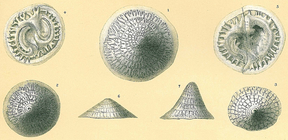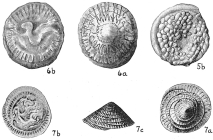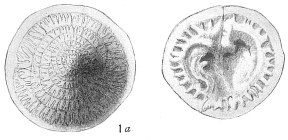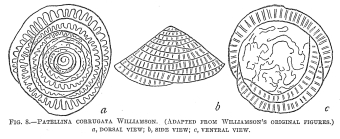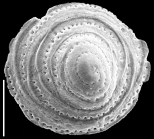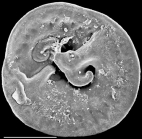Foraminifera taxon details
Patellina Williamson, 1858
112240 (urn:lsid:marinespecies.org:taxname:112240)
accepted
Genus
Patellina corrugata Williamson, 1858 (type by monotypy)
Arpatellum Rhumbler, 1913 · unaccepted (Opinion of Loeblich & Tappan, 1987)
Discobolivina Hofker, 1951 · unaccepted (Objective synonym, Loeblich &...)
Objective synonym, Loeblich & Tappan, 1987
Praepatellina McCulloch, 1977 · unaccepted (subjective junior synonym in...)
subjective junior synonym in opinion of Loeblich & Tappan, 1987
- Species Patellina advena Cushman, 1922
- Species Patellina africana Lambert & Scheibnerová, 1974 †
- Species Patellina altiformis Cushman, 1933
- Species Patellina ambigua Le Calvez, 1949 †
- Species Patellina antarctica Parr, 1950
- Species Patellina antiqua Chapman, 1894 †
- Species Patellina arubiana McCulloch, 1981
- Species Patellina caledoniana McCulloch, 1981
- Species Patellina corrugata Williamson, 1858
- Species Patellina cretacea Plotnikova, 1967 †
- Species Patellina crista Lalicker, 1950 †
- Species Patellina dentata Terquem, 1882 †
- Species Patellina douvillei Said & Barakat, 1958 †
- Species Patellina edita Botvinnik, 1971 †
- Species Patellina elaborata McCulloch, 1977
- Species Patellina elliotti Stelck & Wall, 1956 †
- Species Patellina erugata McCulloch, 1981
- Species Patellina formosa Heron-Allen & Earland, 1932
- Species Patellina gigantea Todd, 1970 †
- Species Patellina inornata (McCulloch, 1977)
- Species Patellina leganyii Kenawy & Nyírő, 1967 †
- Species Patellina lucida Le Calvez, 1949 †
- Species Patellina neocomica Tairov, 1960 †
- Species Patellina nitida Terquem Em. Le Calvez, 1949 †
- Species Patellina oolithica Terquem, 1882 †
- Species Patellina pilasensis McCulloch, 1977
- Species Patellina piripaua Finlay, 1939 †
- Species Patellina puncata Terquem, 1880
- Species Patellina simplissima (McCulloch, 1977)
- Species Patellina spinosa Zheng, 1979
- Species Patellina subcretacea Cushman & Alexander, 1930 †
- Species Patellina transcarpatica Venglinsky, 1975 †
- Species Patellina trochiformis (Schacko, 1892) †
- Species Patellina vitrea Ebensberger, 1962 †
- Species Patellina aegyptiensis Chapman, 1900 † accepted as Patellina egyptiensis Chapman, 1900 † accepted as Dictyoconus egyptiensis (Chapman, 1900) † (Nomen rejectum, ICZN op. 585)
- Species Patellina aptica Agalarova, 1951 † accepted as Paleopatellina aptica (Agalarova, 1951) † (Type species of Paleopatellina)
- Species Patellina bradyana Howchin, 1888 † accepted as Howchinia bradyana (Howchin, 1888) † (Type species of Howchinia)
- Species Patellina campanaeformis Brady, 1884 accepted as Alanwoodia campanaeformis (Brady, 1884)
- Species Patellina conica Halkyard, 1918 † accepted as Chapmanina gassinensis (Silvestri, 1905) † (Subjective junior synonym Opinion of Poignant (2018))
- Species Patellina egyptiensis Chapman, 1900 † accepted as Dictyoconus egyptiensis (Chapman, 1900) † (Type species of Dictyoconus)
- Species Patellina feifeli (Paalzow, 1932) † accepted as Rumanolina feifeli (Paalzow, 1932) †
- Species Patellina hanzawai (Asano, 1936) accepted as Patellinella hanzawai Asano, 1936
- Species Patellina jonesi Howchin, 1895 † accepted as Hergottella jonesi (Howchin, 1895) † (Type species of Hergottella)
- Species Patellina nitida Terquem, 1882 † accepted as Patellina nitida Terquem Em. Le Calvez, 1949 †
- Species Patellina plicata Terquem, 1876 accepted as Remaneica plicata (Terquem, 1876) (Opinion of Lévy et al. (1974, 1975))
- Species Patellina protea Cushman & Waters, 1928 † accepted as Abadehellopsis protea (Cushman & Waters, 1928) † (unaccepted > superseded combination, Opinion of Vachard in Granier et al. (2022))
- Species Patellina scutum Fritsch, 1878 † accepted as Orbitolina scutum (Fritsch, 1878) † accepted as Palorbitolina lenticularis (Blumenbach, 1805) † (unaccepted > superseded combination, Opinion of Yabe and Hanzawa (1926, 1931))
- Species Patellina trochus Fritsch, 1878 † accepted as Orbitolina trochus (Fritsch, 1878) † accepted as Palorbitolina lenticularis (Blumenbach, 1805) † (Opinion of Yabe and Hanzawa (1926), Silvestri (1932))
- Species Patellina turriculata Dieni & Massari, 1966 † accepted as Rumanolina turriculata (Dieni & Massari, 1966) † (Opinion of Neagu and Cîrnaru (2002))
marine, brackish, fresh, terrestrial
Williamson, W.C. (1858). On the recent Foraminifera of Great Britain. <em>The Ray Society, London.</em> 1-107., available online at https://archive.org/details/onrecentforamini00will/page/n0 [details] 
Type locality contained in Great Britain
type locality contained in Great Britain [details]
Diagnosis Test low conical, planoconvex, all chambers visible from the convex spiral side, only the final pair of the last whorl...
Diagnosis Test low conical, planoconvex, all chambers visible from the convex spiral side, only the final pair of the last whorl visible on the flattened umbilical side, periphery carinate, the keel projecting from the basal surface so that it supports the test and prevents it from resting on the umbilical wall, proloculus followed by undivided coiled tubular chamber of one to three whorls that form in a single growth stage, later stage in the agamont with two broad and low crescentic chambers per whorl, under favorable conditions gamonts may reproduce immediately after formation of the spiral chamber, but semicircular chambers are formed if reproduction is delayed, distal end of the tubular chamber and of later biserial chambers turned sharply toward the umbilical area so that the aperture opens toward the umbilicus, chambers subdivided in the outer part by numerous short radial septula and may have an additional intercalated series of shorter septula, the septula extending for about the width of the chamber that is visible from the spiral side but not extending to the umbilicus of the opposite side, interior with a scroll-like median septum resulting from the sharp turn of the two edges of each chamber where the aperture is directed toward the umbilicus, those of successive whorls building a median columella; wall calcareous, acting as a single crystal of high magnesium calcite with preferred orientation of c-axis parallel to the umbilical surface and a-axis parallel to the axis of coiling, growth occurs by lateral accretion along the edge of the chamber wall and does not form an organic template, wall of a new chamber first forms on the spiral side and radial septula and underlying basal plates then arise from the peripheral carina, continued growth and fusion of the basal plates forms the lower wall of the test, basal plates in early development showing angular edges that correspond to the crystal faces and a funnel-like central depression consistent with development as a crystal skeleton in a supersaturated solution, pseudopores originate as indentations in the upper chamber wall between the septula, are filled with organic matter, and locally suppress calcification during wall construction, pores closed internally by pore sieve-plates that do not allow passage of cytoplasm but may allow transfer of gases or dissolved nutrients, test surfaces covered by a thin organic membrane continuous with that of the pore canals, that prevents deposition of secondary lamellae; aperture a low opening at the end of the semicircular chamber, where it turns sharply toward the umbilicus, later covered by a broad T-shaped apertural plate with recurved ends, apertures of successive chambers approximately 180¡ apart, each successively in a lower plane, rarely more than one aperture may be produced due to bifurcation of the chamber near the umbilical termination. L. Cretaceous (Aptian) to Holocene; cosmopolitan. (Loeblich & Tappan, 1987, Foraminiferal Genera and Their Classification) [details]
Hayward, B.W.; Le Coze, F.; Vachard, D.; Gross, O. (2021). World Foraminifera Database. Patellina Williamson, 1858. Accessed at: https://marinespecies.org/foraminifera.../aphia.php?p=taxdetails&id=112240 on 2024-11-19
Date
action
by
2006-09-27 07:06:07Z
changed
Martinez, Olga
original description
Williamson, W.C. (1858). On the recent Foraminifera of Great Britain. <em>The Ray Society, London.</em> 1-107., available online at https://archive.org/details/onrecentforamini00will/page/n0 [details] 
original description (of Praepatellina McCulloch, 1977) McCulloch, I. (1977). Qualitative observations on Recent foraminiferal tests with emphasis on the eastern Pacific. University of Southern California. Los Angeles., available online at https://books.google.com/books?id=tPw_AAAAIAAJ [details] Available for editors [request]
[request]
original description (of Arpatellum Rhumbler, 1913) Rhumbler, L. (1913). Die Foraminiferen (Talamophoren) der Plankton-Expedition. Zugleich Entwurf eines natürlichen Systems der Foraminiferen auf Grund selektionistischer und mechanisch-physiologischer Faktoren. Zweiter Teil : Systematik. <em>Ergebnisse der Plankton-Expedition der Humboldt-Stiftung.</em> Bd.3 L.c.: 332-476., available online at https://www.biodiversitylibrary.org/page/2124278 [details]
original description (of Discobolivina Hofker, 1951) Hofker, J. (1951). The Toothplate-Foraminifera. <em>Archives Néerlandaises de Zoologie.</em> 8(1), 353-373., available online at https://doi.org/10.1163/187530151x00072
page(s): p. 358 [details] Available for editors [request]
[request]
basis of record Gross, O. (2001). Foraminifera, <B><I>in</I></B>: Costello, M.J. <i>et al.</i> (Ed.) (2001). <i>European register of marine species: a check-list of the marine species in Europe and a bibliography of guides to their identification. Collection Patrimoines Naturels,</i> 50: pp. 60-75 (look up in IMIS) [details]
additional source Neave, Sheffield Airey. (1939-1996). Nomenclator Zoologicus vol. 1-10 Online. <em>[Online Nomenclator Zoologicus at Checklistbank. Ubio link has gone].</em> , available online at https://www.checklistbank.org/dataset/126539/about [details]
additional source Loeblich, A. R.; Tappan, H. (1987). Foraminiferal Genera and their Classification. Van Nostrand Reinhold Company, New York. 970pp., available online at https://books.google.pt/books?id=n_BqCQAAQBAJ [details] Available for editors [request]
[request]
original description (of Praepatellina McCulloch, 1977) McCulloch, I. (1977). Qualitative observations on Recent foraminiferal tests with emphasis on the eastern Pacific. University of Southern California. Los Angeles., available online at https://books.google.com/books?id=tPw_AAAAIAAJ [details] Available for editors
original description (of Arpatellum Rhumbler, 1913) Rhumbler, L. (1913). Die Foraminiferen (Talamophoren) der Plankton-Expedition. Zugleich Entwurf eines natürlichen Systems der Foraminiferen auf Grund selektionistischer und mechanisch-physiologischer Faktoren. Zweiter Teil : Systematik. <em>Ergebnisse der Plankton-Expedition der Humboldt-Stiftung.</em> Bd.3 L.c.: 332-476., available online at https://www.biodiversitylibrary.org/page/2124278 [details]
original description (of Discobolivina Hofker, 1951) Hofker, J. (1951). The Toothplate-Foraminifera. <em>Archives Néerlandaises de Zoologie.</em> 8(1), 353-373., available online at https://doi.org/10.1163/187530151x00072
page(s): p. 358 [details] Available for editors
basis of record Gross, O. (2001). Foraminifera, <B><I>in</I></B>: Costello, M.J. <i>et al.</i> (Ed.) (2001). <i>European register of marine species: a check-list of the marine species in Europe and a bibliography of guides to their identification. Collection Patrimoines Naturels,</i> 50: pp. 60-75 (look up in IMIS) [details]
additional source Neave, Sheffield Airey. (1939-1996). Nomenclator Zoologicus vol. 1-10 Online. <em>[Online Nomenclator Zoologicus at Checklistbank. Ubio link has gone].</em> , available online at https://www.checklistbank.org/dataset/126539/about [details]
additional source Loeblich, A. R.; Tappan, H. (1987). Foraminiferal Genera and their Classification. Van Nostrand Reinhold Company, New York. 970pp., available online at https://books.google.pt/books?id=n_BqCQAAQBAJ [details] Available for editors
 Present
Present  Inaccurate
Inaccurate  Introduced: alien
Introduced: alien  Containing type locality
Containing type locality
From editor or global species database
Diagnosis Test low conical, planoconvex, all chambers visible from the convex spiral side, only the final pair of the last whorl visible on the flattened umbilical side, periphery carinate, the keel projecting from the basal surface so that it supports the test and prevents it from resting on the umbilical wall, proloculus followed by undivided coiled tubular chamber of one to three whorls that form in a single growth stage, later stage in the agamont with two broad and low crescentic chambers per whorl, under favorable conditions gamonts may reproduce immediately after formation of the spiral chamber, but semicircular chambers are formed if reproduction is delayed, distal end of the tubular chamber and of later biserial chambers turned sharply toward the umbilical area so that the aperture opens toward the umbilicus, chambers subdivided in the outer part by numerous short radial septula and may have an additional intercalated series of shorter septula, the septula extending for about the width of the chamber that is visible from the spiral side but not extending to the umbilicus of the opposite side, interior with a scroll-like median septum resulting from the sharp turn of the two edges of each chamber where the aperture is directed toward the umbilicus, those of successive whorls building a median columella; wall calcareous, acting as a single crystal of high magnesium calcite with preferred orientation of c-axis parallel to the umbilical surface and a-axis parallel to the axis of coiling, growth occurs by lateral accretion along the edge of the chamber wall and does not form an organic template, wall of a new chamber first forms on the spiral side and radial septula and underlying basal plates then arise from the peripheral carina, continued growth and fusion of the basal plates forms the lower wall of the test, basal plates in early development showing angular edges that correspond to the crystal faces and a funnel-like central depression consistent with development as a crystal skeleton in a supersaturated solution, pseudopores originate as indentations in the upper chamber wall between the septula, are filled with organic matter, and locally suppress calcification during wall construction, pores closed internally by pore sieve-plates that do not allow passage of cytoplasm but may allow transfer of gases or dissolved nutrients, test surfaces covered by a thin organic membrane continuous with that of the pore canals, that prevents deposition of secondary lamellae; aperture a low opening at the end of the semicircular chamber, where it turns sharply toward the umbilicus, later covered by a broad T-shaped apertural plate with recurved ends, apertures of successive chambers approximately 180¡ apart, each successively in a lower plane, rarely more than one aperture may be produced due to bifurcation of the chamber near the umbilical termination. L. Cretaceous (Aptian) to Holocene; cosmopolitan. (Loeblich & Tappan, 1987, Foraminiferal Genera and Their Classification) [details]
